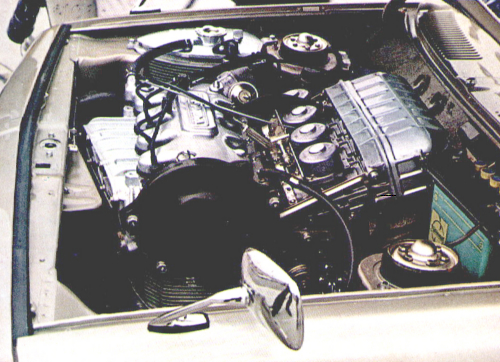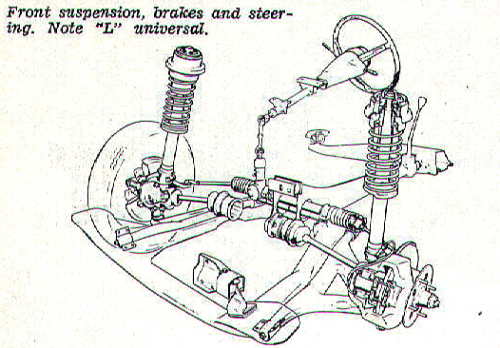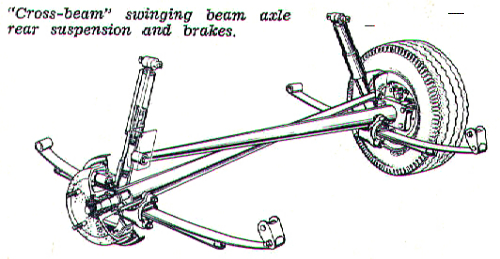


Our Japanese Correspondent, Jock Yamoguchi gives a technical analysis of the brilliant Honda 1300 and his first driving impressions. At earliest, the 1300 will arrive in Australia late 1969.
MR SOICHIRO HONDA's order was indeed a tall one. He wanted a popularly priced, family sedan powered by an aircooled 1.3-litre engine, which combines interior dimensions of the average 1.5-litre Japanese sedan, performance of a modern 2-litre engine and economy of a 1-litre small ear. And its air-cooled engine should maintain a noise level comparable with a water-cooled four.
No member of Mr Honda's army of enthusiastic engineers shrugged his shoulders or quietly immigrated to the new world, for the Honda Research and Development Centre immediately went into high gear on the Project 1300. By October 1968, a fleet of prototype cars was completed and shown to the press.
Although no press member was allowed to drive the car, the engine of one stationary car was fired up and revved to Valhalla. That it didn't break the tranquility of a peaceful garden of the former residence of a royal prince where the ear was shown should endorse Mr Honda's choice comment that "our new car" was far quieter than a certain well-known German rear-englned automobile.
In late February this year, Honda sent out a brief press release informing that the price announcement of the 1300 would be slightly behind schedule. There was a footnote in the release, however, advising that if any press member should be interested in trying the "existing" prototype, he would be welcome to visit their test track near Tokyo. As several bus loads of eager motoring and non-motoring journalists swarmed into the track, each could be allocated with only one lap of the two kilometre course. I pretended my name wasn't Yamaguchi, and managed two extra laps. The six kilometre drive proved to me that the Honda 1300 was an exceptionally fast car for its engine size, and it was very, very quiet considering its cooling system by Mother Nature. The prototype, however, displayed rather pronounced understeering characteristics and very strong castor action. It was as if a naughty green giant was hiding behind the steering gear, stubbornly trying to keep the car running in a straight line.
On April 15, the final production versions as well as prices were released. On the following day, the press corps was boarded on the famous Bullet Express which swiftly transported us to the city of Nagoya, thence another train ride to the home of Honda Formula One car, the Suzuka Racing Circuit, where we were let loose in several 1300s.


Before going into driving impressions of the 1300, a technical analysis of this unique piece of engineering must be due. Most obvious feature of the engine is its cooling system. Both the die-cast aluminium, alloy cylinder head and block have integral cast-in cooling shrouds. The outer surface of the "shroud" is horizontally finned, and that of the "inner" block is. vertically finned. The fins are shallow and sturdy enough to eliminate high frequency vibration, or ringing as they call it, which is a major source of noise in an air-cooled engine, A multi-blade cooling blower is mounted on, one end of the crankshaft, and turns at engine speed. The crankcase surface is also extensively finned. Engine lubricant also plays an important role in cooling effect. The engine features dry sump lubrication by twin gear type pumps and an aluminium tank which holds 7 pints of lubricant. The tank is also finned and acts as an oil cooler. The cylinder block is of die-cast aluminium alloy, and cast iron liners are pressed in. Bore and stroke are 74 x 75.5 mm for a total displacement of 1298 cc. The long stroke helps to keep the engine compact, and presents no problem in smooth running in the designed rpm range. After all, the 1300 unit produces peak power at a modest 7200 rpm.
The cylinder head is also of one piece die-cast aluminium, and features cross-flow ports and hemispherical combustion chambers. A single overhead camshaft is supported by three plain bearings, and is driven by single-stage, single row Morse Hivo silent chain. It acts on two valves per cylinder disposed at a 56 degree angle, via. rockers. Valve diameters are 37 and 33mm for intake and exhaust respectively.
The 1300 engine is the first Honda car engine which does not feature a built-up, roller bearing supported crankshaft. The 1300 crank is forged in one piece and supported by five aluminium alloy plain bearings. It comes in two stages of tune: Series 77 which is fitted with a modest 36 mm Keihin variable venturi sidedraught carburettor, producing 100 hp at 7200 rpm (four more horses than the prototype's 96 hp) and putting out a maximum torque of 79.2 lb-ft at 4500 rpm, and Series 99 high performance version which sports four 36mm Keihins and puts out 115 hp at 7500 rpm and a maximum torque of 87.1 lb-ft.


TRANSMISSION:
A conventional single dry plate clutch of 180 mm diameter is mounted on the nearside end of the engine. Power is transmitted by Morse Hivo silent chain (1 in. wide) to the Honda four-speed all syncro gearbox. Primary reduction ratio between the engine and the gearbox is 1.2400:1, and gearbox internal ratios are 3.4462, 2.0140, 1.3675 and 1.0000, combined to the final ratio of 3.5000:1. Gearbox ratios are wider spaced than those of the prototype's very close box. Constant velocity joints are used on both ends of the drive shaft, and a sliding spline is incorporated at mid-length. Transmission has its own wet sump with a trochoid pump. The single carburettor 77 power unit including transmission and lubricant tank weighs 179 kg.

Yamaguchi tries 77 version of Honda 1300 on Suzuki circuit

Side view of slower 77 version shows extractor vents at rear

More powerfull 99 'S' Version
For the sleek shape Honda had promised, we would have to wait until a sportier coupe version is released in autumn. The front suspension is by MacPherson struts and wide-based lower arms. Rear suspension is another interesting feature of the 1300. Twin, welded tubular arms extend almost the full width of the chassis. One end of the arm is pivoted at the outer edge of the chassis, and the rear wheel is mounted on the other end, so it is a swing axle system with geometry similar to that obtained with many modern semi-trailing layouts. Conventional semi-elliptic springs are used.




Brakes are Girling disc brakes at the front and leading-trailing shoe drums at the rear. Vacuum servo assistance and pressure limiting valve are standard equipment on the 1300, except the basic model which comes sans vacuum servo.
Steering is by rack and pinion system with a gear ratio of 19.6:1. Two Joints are incorporated in the steering linkage, which collapse on impact. Tyres are now Otsu ultra low profile cross-ply 6.20S-13 on 4J rims. Radials may be specified on the faster 99 model.
The 1300 measures 12 ft 8.9 in. long on an 88.6 in. wheelbase, 4 ft 9 in. wide with 59.0/48.0in. tracks, and 4ft 5 in. tall. So it is about the size of the VW Beetle. It has gained some 220 lb over the prototype, and the 77 De Luxe now scales 17.4 cwt
HOW GOOD IS THE 1300?
Everyone present at the February jaunt at the Research and Development Centre test track was impressed by the tremendous straight line performance of the 1300. Honda claimed a top speed of 110 mph and a standing quarter mile time of 17.2 sec. We all felt the "prototype" 1300 was capable of achieving these figures.
The production 77 gained 4 hp over the proto, but also put on some extra weight. It also comes with a gearbox with wider spaced ratios. Although Honda did not take any chances in allowing those mad journalists to really step on the gas pedal (a stop at the "control" station in the middle of Suzuka's long straight was mandatory) in the wet, I saw 140 kph (90 mph) on the back stretch and the engine was pulling quite strongly.
And it was no noisier than a comparable watercooled four. It revved up smoothly without fuss and fury. The gearbox was one of the best found in Japanese cars with strong syncromesh action and really usable intermediate ratios. When called for, third would take it close to 75 mph.
Handling of the production 1300 was far better than I had anticipated. Gone was that strong self-centring action, though understeering was still there. Steering ratio was lowered from the proto's 17.6:1 (3.2 turns lock to lock) to 19.6:1 which calls for four turns of the simulated woodrim wheel.
It was fairly light even in tight manoeuvring. Brakes proved to be up to the performance of this hot Honda. Pedal pressure was reasonable and the brakes were progressive in action.
We found the body shell of the Honda 1300 was quite acceptable in dimensions. But westerners may think it was a bit on the smaller size, especially for a car with four doors. The interior was quite well appointed. Various controls were in the right locations and front seats held occupants well, indicating Honda did have engineering staff who liked to drive. And one of the faster Honda men is undoubtedly the Old Man himself. I witnessed Mr Honda doing a most violent manoeuvre snaking at absurdly high speed. And the 1300 didn't seem to mind its Master's rough handling.
The Honda 1300 is almost un-Japanese in performance and handling, and is certainly equal to the best of European small cars, I had a firm personal belief that I wouldn't need a personal transport which was dearer than half a million Yen (approx $A1250) but I have since raised the limit by $A180. Yes, I am now eagerly awaiting the delivery of my personal Honda 1300.

Luxury - sporting note for 99 interior - console and leather wheel.
